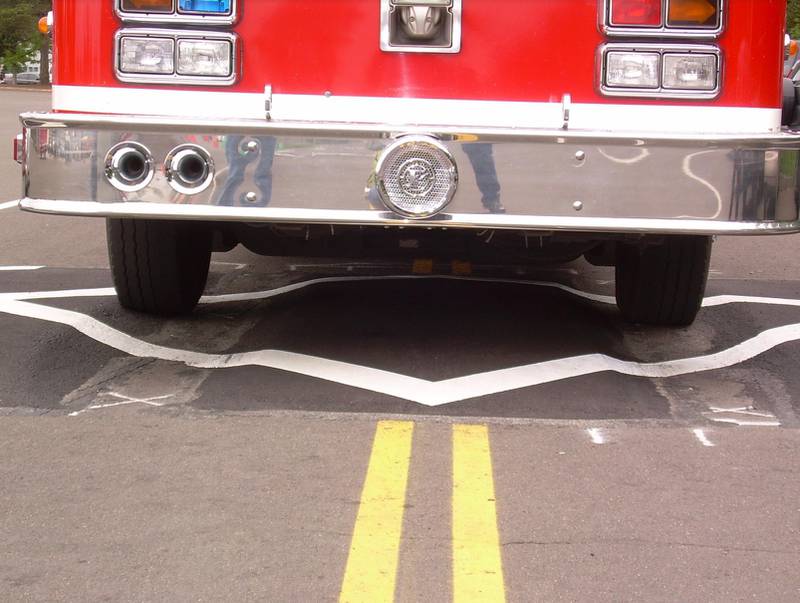
Speed bumps on Portland’s neighborhood greenways are a double-edged sword. They’re effective tools for slowing car traffic, making it safer and more comfortable to ride a bike on a street shared with cars. On the other hand, they can be unpleasant for people riding bikes to navigate over, adding some unfortunate nuisance to a bike trip on a greenway.
Then there are the ones with tire gaps.
When these types of speed bumps were first installed on the Clinton Street Greenway several years ago, they sparked a pretty heated debate. Are they for bikes specifically? Isn’t it less safe if drivers swerve to use them? Aren’t they only for emergency vehicles?
Recently, the issue came up again in the comments section of a BikePortland Instagram post about new bike-friendly speed bumps on NE Alameda. The consensus from naysayers seems to be that these gaps tempt drivers to dangerously shoot through them so they can avoid hitting the speed bump.
“I feel these encourage cars to veer from their lane and cause erratic, unpredictable behavior,” one commenter said.
“I watched no fewer than six people crash in a single Pedalpalooza ride when they haphazardly installed the NE 28th ones,” someone else wrote.
“I have always wondered how these are supposed to work. I have ridden my bike thru the dip but it put me towards the middle of the road and resulted in getting honked and yelled at by a car. Are they supposed to be for bikes to avoid the hump?”
Lots of questions. And a bit of confusion and concern. So we reached out to PBOT to find out what’s up…
According to the Portland Bureau of Transportation, there are two different types of speed bump gaps on Portland’s streets. The first were designed in response to complaints from emergency vehicle operators who said these traffic calming measures were slowing down emergency response times. These speed bump channels split the speed bump into multiple “cushions” narrow enough that a fire truck driver can bypass hitting the bump. The second type — the “bike-friendly gaps” — were developed later as a variation of the emergency response vehicle speed bump treatment.
“The fire-friendly speed bumps were created to slow people who speed on local and small collector streets without sacrificing emergency response time,” PBOT Public Information Officer Dylan Rivera said in an email to BikePortland. “Having received complaints from people biking about the speed bumps, dating back to when we first began installing them, we thought a different design with a channel in a different location could be a desired improvement for neighborhood greenways.”
Rivera said that so far, PBOT has had “good results on speed reduction” on the neighborhood greenways where they’ve installed these speed bumps
“Their intention is to provide a more convenient trip for cyclists, prioritizing their positioning on the road without sacrificing speed reduction,” Rivera said. “So these days, Portland has fire-friendly and bike-friendly speed bumps.”
I was personally surprised to discover how controversial these speed bump gaps are. I immediately noticed the treatment upon beginning to bike around Portland, and I always thought it was a nice idea. I invariably groan a bit whenever I have to roll over a speed bump (especially when on an e-bike with its higher speeds), so I’ll always aim for the gap if one is available.
I agree that too many car drivers swerve to use the gaps even though they aren’t supposed to. After all, speed bumps are installed to force drivers to slow down, and when so many of our streets were built to allow people in cars to go as fast as possible, this can be a hard pill for some people to swallow.
This is a tricky problem to solve. In my opinion, the solution isn’t to completely get rid of treatments like this. Instead, it needs to be more apparent to people driving that neighborhood greenways are meant to prioritize bicycling. This could be accomplished with more traffic diverters and signage that, hopefully, would change behavior over time and make greenways more comfortable and safer for people biking and using active transportation. Maybe one day, drivers will be so calm that speed bumps are no longer necessary!
Luckily for everyone who isn’t such a big fan of these “bike-friendly” speed bumps, it doesn’t look like PBOT will be installing them just everywhere yet.
“They’re not yet a standard tool. We are in the process of learning what we can, both about effectiveness and design,” Rivera said.
So, what do you think about the speed bump gaps? Are they helpful or do you think they just cause more problems?




